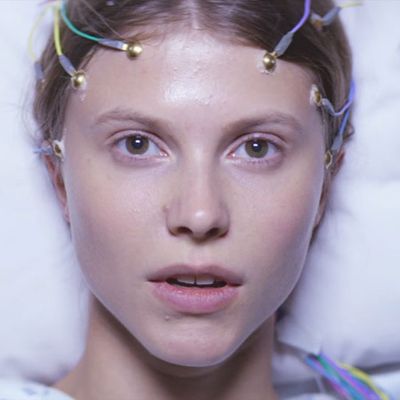
The fun part of Joachim Trier’s Thelma is trying to reconcile its gorgeous, art-house Scandinavian look with its exploitation-horror-movie plot, which makes the whole thing feel like Carrie remade by Ingmar Bergman. So I’ll try to tiptoe to the edge of clarity without slipping over. No spoilers.
Thelma is a female coming-of-age film in which latent psychic powers add an eerie extra dimension, as does the buttoned-up Scandinavian mood. The style is formal, as meticulous as Hitchcock but with even more longueurs, like the lengthy overhead shots of the clean, impersonal college crosswalk where students pass one another by — so close yet so far. As the teenage title character, Eili Harboe stares out her dorm-room window at the plaza below, knowing no one, afraid to interact.
She has good reason, it turns out. Her anxious father, Trond (Henrik Rafaelsen), and emotionally ravaged mother, Unni (Ellen Dorrit Petersen), are religious fundamentalists who’ve embraced the Creator desperately, as if fleeing the fires below. They’ve sheltered Thelma, kept her childlike and removed from the state of nature. But nature creeps back into her life, as it must. Hitchcockian birds gather. A snake slips into a campus building. More birds. More portent. In the library, Thelma trades glances with a fellow female student and something stirs in her, literally as well as figuratively: She collapses, seizing. After a few more such incidents there’s one of those brain-scan scenes in which the wires stuck on Thelma’s head look like bolts of electricity and the doctors stare at the readout with widening eyes.
Thelma’s friendship with that young woman, Anja (Kaya Wilkins), grounds the second part of the film in the “love that dare not speak its name” — particularly if one’s parents are fundamentalist Christians terrified of unleashing primal forces. Those forces extend to the audience. Thelma opens with a warning to epileptics and Thelma opens with a warning to epileptics and others averse to strobe lights, and I heartily agree: The strobe-y dancing scenes are intense. I thought I might have a seizure.
On paper, Thelma sounds predictable: revenge of the repressed … liberation of the feminine … the delayed expression of what Camille Paglia calls women’s “chthonian nature.” And the final scene, alas, reduces everything that has preceded it to a point where it’s flat-out insulting. But the rest is entrancingly beautiful art-horror. A late flashback is filled with poetically terrifying images — images you might wish you could unsee. A final scene between Thelma and her father in the middle of a fjord is an uncanny mixture of lyricism and gruesomeness. (It’s too bad the film doesn’t end there.) Throughout, Harboe has a soft face you can’t stop watching — it suggests she’s always one step behind her emotions, being led who knows where?
The Norwegian Trier (who wrote the script with his frequent partner, Eskil Vogt) has now made four good movies, none in a similar key. His first, Reprise, is a tricky, psycho-dramatic buddy movie. Oslo, August 31st is a switchback ride to suicide — the second go (after Louis Malle) at the novel The Fire Within. Louder Than Bombs is a moving American family drama that unfortunately bombed quietly. Thelma is both more mysterious and more accessible than his other films. The spell it casts transcends the silly plotting. It puts you in a zone all its own.


